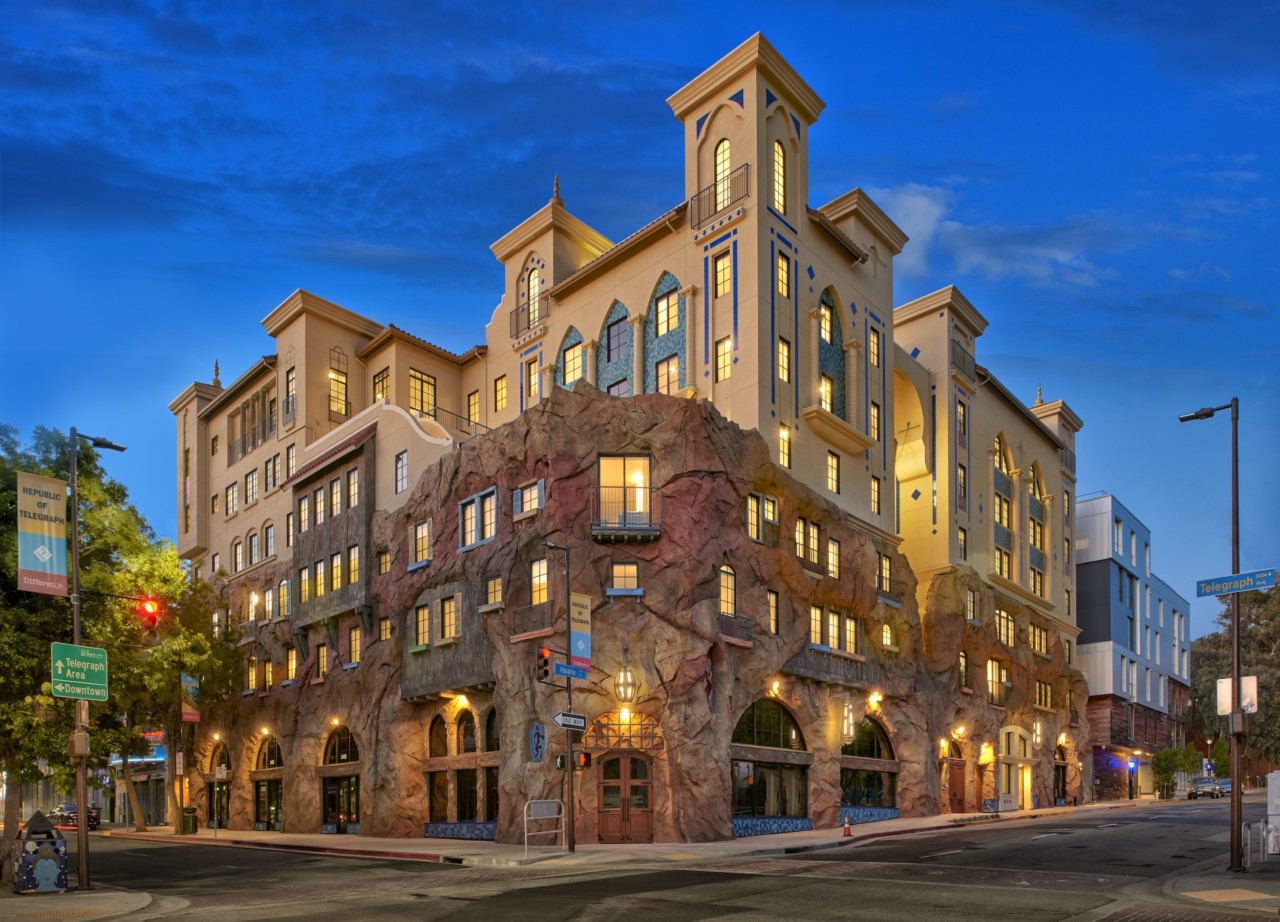Walnut Creek, California-based LCA Architects has shared final photos of the Enclave, its student dormitory project for the University of California, Berkeley. The minaret-topped co-living Moorish castle completed earlier this fall and continues to provide a fresh new source of rubbernecking on the corner of Telegraph Avenue and Haste Street.
Even before the wood-framed mixed-use building, which features 11,000 square feet of ground-level retail topped by 55 fully-furnished independent living apartments with shared bathrooms, kitchens, and living/dining areas for continuing and graduate students, was fully finished, its “singular” design was already the talk of the town as it doesn’t resemble anything ever seen on Berkeley’s busy Telegraph Avenue… or in the entire Bay Area, really.
Rising seven stories atop a craggy, cliff-like base with an ersatz stone facade on what was once a long-vacant lot, the Moorish-style structure with a dash of Tudor flair was first envisioned as a fantastical project dubbed La Fortaleza—later El Jardin—by Ken Sarachan, owner of local indie record store chain Rasputin Music. As reported by the San Francisco Chronicle in September, Sarachan first purchased the lot, previously the site of a hotel that was destroyed by fire in the 1980s, in 1994.
In 2011, the city threatened to foreclose on the still-vacant property. The following year, any legal tussles subsided and Sarachan tapped Oakland-based architect Kirk Peterson to design an unparalleled new addition to Telegraph Avenue that, in the words of Peterson “looked like a wizard building.” However, progress on the project came to a standstill and in 2016 Jarvis Architects was brought in to “repackage the whimsies in more standardized form” per the Chronicle.
In 2018, the project started to show signs of renewed life after Sarachan sold the property to Todd Whitlock of WEST Builders. Berkeley’s zoning board gave the final green light to the refreshed project, now dubbed the Enclave Dormitory, in July of that year, and at long last, construction on the building commenced soon thereafter. As reported by Berkeleyside, WEST tapped LCA Architects to finalize the design of the Enclave, which includes an additional floor, some lower-level layout changes, as well as room for 16 more beds for students, bringing the current total to 254.
David Bogstad, president of LCA Architects, told Berkeleyside in 2018 that promised that the years-in-making project would be a “special building for the city.”
And special the finished result is.
While Peterson’s original vision that incorporated a mishmash of exotic architectural influences and concepts has been altered since the project first took fruition, the singular spirit of the original design is still apparent in the building that stands at Telegraph and Haste today. In his largely positive assessment for the Chronicle, urban design critic John King noted the building’s “nutty gravitas” and applauded its designers for taking a sharp detour from the forgettable and the formulaic to create a structure that appears “as if Harry Potter and Fred Flintstone decided to build a McMansion. On acid.”
While there’s nothing else quite like it in Berkeley (or likely in the annals of dormitory architecture), echoes of village-perched-atop-a-mountain concept of the Enclave has been seen elsewhere this year. MAD Architects’ Gardenhouse, which was revealed in August in Beverly Hills, similarly evokes a cloistered hilltop hamlet although that project emerges from a base clad in lush vegetation, not a rock-like concrete facade on par with something you might find at a Disney theme park. (As noted by the Chronicle, COST, a fabricator that has worked for Disney and Universal Studios, had a hand in creating the faux cliff that comprises the building’s lower level.)
Love it or hate it, there’s no ignoring the new UC Berkeley dorm at Telegraph and Haste. Speaking to the Chronicle, Berkeley City Council member Rigel Robinson counts himself as being among the divisive building’s fan. “I love that it’s so spunky,” he said. “This is a treasure.”
Among those who have reacted not-so-glowingly to the Enclave is Peterson himself, who was originally commissioned to design the building nearly a decade ago. “I wanted to make art. I wanted to do a correct, authentic, historicist building,” he told Berkeleyside when the scaffolding first came off in February of this year. Per Berkeleyside, Petersen reportedly studied “cave dwellings in the South of France, the architecture of Yemen, the Alhambra, Baroque churches in provincial Italy, and the work of Julia Morgan” in conceiving his initial design, with all of these disparate influences coming together to resemble a design that evoked a small Italian village perched atop a rocky outcrop.
In addition to living accommodations for 254 students who will likely have very little trouble describing which off-campus dorm that they live in, the Enclave includes a courtyard area, on-site laundry, study lounges, fitness center, roof deck, and public art elements including mosaics by Kori Girard and large-scale suspended sculptural light fixtures by Rebecca Anders.
